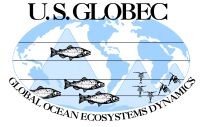
Participants
__________
GLOBEC
International
__________
| GLOBEC Northeast Pacific Program Mapping of Physical and Biological Fields in the Northern California Current July 31 - August 19, 2002 |
 |
Questions and Answers On this page your will find questions and answers regarding the cruise. Questions had been submitted by visitors to the Hatfield Marine Science Center and by email from website viewers.
Answer: No. The system only uses waste heat that would otherwise escape the ship. The system is so efficient that the reverse-osmosis fresh water generator is rarely used.
Question: What would cause a chlorophyll-rich eddy and why is it important to know about? -From Judy C. August 7, 2002 Answer: In the same way that atmospheric movement causes eddies in the air, currents in the ocean can create large scale eddies. The presence of chlorophyll indicates that this water most likely originated near the coast and was moved far offshore. It is important to study in part because it may be a significant component of the currents off Oregon. It may also indicate a movement of carbon from coastal waters into the offshore waters.
Question: How does the "red tide" affect the animals at sea (plankton, salmon, mammals, etc.) off our coast? How do we know when a "red tide" is going to occur, or when it is occurring? -From a visitor to the Hatfield Marine Science Center on August 5, 2002.
Answer: Red tides are causes by a large increase in algae that
produce toxins and can occur during warm, calm ocean conditions with
sunny days. Filter feeder shellfish-- clams mussels, and
oysters-- will take in the toxin. Animals and people who
eat those shellfish can be affected. It affects the nervous
system and can cause a reaction ranging from a tingling of the lips to
breathing difficulty. When the algae die, decomposition can
remove oxygen from the water affecting fish and other animals.
Question: How many people are on the ship Revelle? How many crew? How many scientists? Why is the ship heading back to Newport?- From JOSHUA and ELIZABETH Answer: There are 25 scientists and 20 crew members on board this cruise. It appears to be headed back to Newport but is in fact on a different line south of Newport. The Revelle will be following a back and forth pattern down the coast for the next few days until we are at the Oregon/California border. During that time the SeaSOAR and HTI will be in the water behind the ship. Follow the ships progress on this path by clicking here.
Answer: The TSRB is set drifting away from the ship while the ship is stationary. Light sensors on the buoy are aimed both up looking at the surface and down into the water column. The upward sensors look at down welling irradiance which measures the intensity and wavelength of light coming down into the water from the surface. The downward sensors measure the light that is reflected off of particles in the water coming up to the surface. The data from the TSRB is used for calculations of primary productivity, water clarity, and for calibrating data from satellites.
|
This page was last updated on August 17, 2002 12:46 PM
.jpg)

